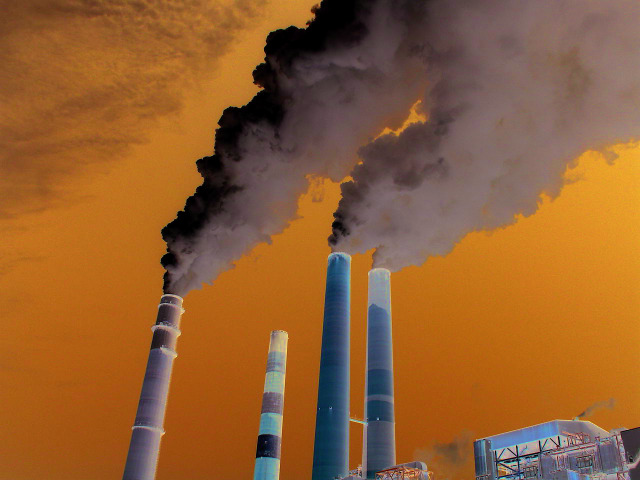Fossil fuel carbon emissions from radiocarbon measurements
Emissions from a coal-fired power plant. Image credit: Wikimedia Commons/Monkeyboy0076.
Carbon dioxide emissions from fossil fuel use (FF CO2) are often tracked using bottom-up inventories of known sources, which are hard to verify independently. Sourish Basu et al. (pp. 13300–13307) report an independent method for estimating FF CO2 based on the isotopic composition of atmospheric CO2. Fossil fuels are depleted in 14C relative to other carbon sources as a result of radioactive decay. Therefore, the relative amount of 14C in atmospheric CO2 provides information on the contribution of FF CO2 to atmospheric CO2. The authors used measurements from the National Oceanographic and Atmospheric Administration’s Global Greenhouse Gas Reference Network to estimate US emissions for the year 2010, the earliest year for which sufficient data are available. US FF CO2 emissions for 2010 estimated in this way were approximately 1,653 TgC, larger than estimates from the US Environmental Protection Agency and other widely used inventories. The authors’ estimated annual emission was comparable to that derived from the high-resolution Vulcan FF CO2 inventory, as were monthly emissions for 9 of 12 months in 2010. The results suggest that atmospheric carbon isotope measurements can be used to independently validate inventory-based estimates of FF CO2 emissions, according to the authors. — B.D.
Mechanism of general anesthesia
Anesthetic drugs have been used and studied for more than a century, but the molecular mechanisms by which they induce loss of consciousness remain unclear. Mahmud Arif Pavel et al. (pp. 13757–13766) report that inhaled anesthetics, such as chloroform and isoflurane, liberate the enzyme phospholipase D2 (PLD2) from sequestration and activate the ion channel TREK-1 through phosphatidic acid production. Previously, the authors proposed that lipid rafts in cellular membranes inactivate PLD2 by preventing the enzyme from interacting with its substrate and producing phosphatidic acid. In the current study, the authors report that general anesthetics such as chloroform, isoflurane, diethyl ether, xenon, and propofol break up lipid rafts, thereby initiating lipid-gated ion channel signaling across cell membranes. The authors further demonstrate that PLD2 inactivation blocks anesthetic signaling in fruit flies and that adding a PLD2-binding domain to an anesthetically insensitive homolog of TREK-1 renders the ion channel sensitive. According to the authors, the findings uncover a plausible mechanism for general anesthesia. — T.J.
Snowball Earth and Great Oxidation Event
Golden crystals of iron sulfide—pyrite—contain information about Earth’s atmosphere from around 2.5 billion years ago.
The Great Oxidation Event (GOE), a global rise in atmospheric oxygen during the Paleoproterozoic Era, occurred close in time to an early global glaciation event called Snowball Earth. Understanding links between the two events requires determining their relative timing, but the timing of the GOE is poorly constrained. Matthew Warke et al. (pp. 13314–13320) uncovered data on sulfur isotope ratios from two sedimentary formations in the Kola Peninsula of northwest Russia. The GOE is recorded in Paleoproterozoic sediments as a shift from mass-independent fractionation of sulfur isotopes to mass-dependent fractionation. Sulfur isotopes in the older of the two formations exhibited patterns consistent with mass-independent fractionation. In the younger formation, the authors found signals of mass-dependent fractionation that predated glacigenic deposits within the same formation. The results suggest that the GOE occurred within the time interval spanned by the two formations, which geochronological constraints place at approximately 2,501–2,434 million years ago. This interval predates the timing of the Paleoproterozoic Snowball Earth glaciation established from geologic formations in South Africa. The results suggest that the GOE predated Snowball Earth and that global glaciation did not cause the GOE, according to the authors. — B.D.
Extinction risk of land-based vertebrates
The world is experiencing its sixth mass species extinction, which harms ecosystem function and endangers human well-being. In the last century, more than 400 vertebrate species have disappeared. To assess the extinction risk faced by terrestrial vertebrates, Gerardo Ceballos et al. (pp. 13596–13602) used data from the International Union for the Conservation of Nature Red List of Threatened Species and from Birdlife International. The authors found that 1.7%, or 515 of 29,400, of the evaluated terrestrial vertebrate species are on the brink of extinction, with fewer than 1,000 remaining individuals. Vertebrates on the brink of extinction are located primarily in tropical and subtropical regions, concentrated in areas that are heavily affected by human activities. Moreover, approximately 84% of the 388 terrestrial vertebrate species that have fewer than 5,000 remaining individuals are located in the same geographical regions as species on the brink and may therefore soon face a similar risk owing to the human-driven collapse of regional biodiversity. Additional analyses suggest that terrestrial vertebrate species on the brink have collectively lost approximately 237,000 populations since 1900. According to the authors, the findings underscore the need for global action to prevent further loss of terrestrial vertebrate species. — J.W.
Developmental plasticity and eusociality
M. genalis female excavating a nest inside a stick on Barro Colorado Island, Panama.
When influenced by environmental factors, developmental processes can spawn new phenotypes from the same genotype without underlying genetic mutations. Novel traits that emerge through this pathway can shape adaptive evolution, but whether such developmental plasticity represents a fundamental source of novel phenotypes in evolution remains unclear. Karen Kapheim et al. (pp. 13615–13625) examined links between developmental plasticity, molecular evolution, and social behavior in the sweat bee (Megalopta genalis), a species in which females exhibit either a eusocial or solitary lifestyle. Using an integrative genomics approach, the authors found that differences in the expression of social behavior corresponded to differences in expression of many of the same genes that determine sex and regulate metamorphosis. Furthermore, the genes’ functions during development influenced how natural selection acted on social behavior. The study also documents a mechanism by which behavioral phenotypes can be inscribed in the genome as changes in the regulatory functions of transcription factors. The findings suggest that developmental plasticity might represent a source of phenotypic variation and might have sparked the evolution of eusociality, according to the authors. — T.J.





